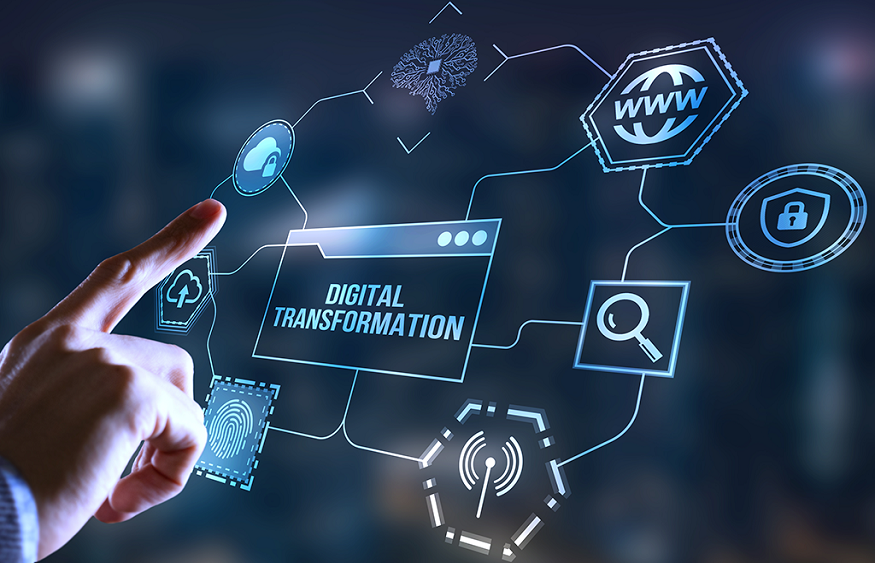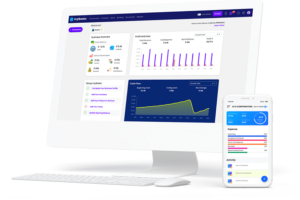Digital Transformation in Utility Industries
7 min read
From power and water supply to waste management, utility companies are constantly stepping up their game by embracing the power of technology to revolutionize the way they operate. So, it’s quite natural for everyone in the industry to focus on digital transformation.
But, how has it worked out for them so far recently?
In this article, we are going to talk about how digital transformation has reshaped the utility and power landscape. There will be some specific examples of the same available in the latter part of this article too. So, make sure to go through this article till the end.
Digitization in Utility Industries: Where Has It Impacted the Most?
There are several industries where we have already found a touch of digital transformation. We have explained a few of them in this segment elaborately.
But, if you’re confused about anything, make sure to ask us in the comment section. We will surely help you out in any way we can. So, let’s get started with it.
1: The Power of Data
Imagine a world where utility companies can predict and prevent power outages before they even happen. Well, thanks to digital transformation, that world is becoming a reality.
By leveraging advanced data analytics and machine learning algorithms, utility companies can analyze vast amounts of data collected from smart meters, sensors, and other devices.
This enables them to detect anomalies, optimize grid performance, and proactively address potential issues. The result – reduced downtime, improved reliability, and happier customers.
2: Smarter Grids
Gone are the days of traditional grids struggling to meet the increasing demands of a growing population. Digital transformation has given birth to smarter grids, which are intelligent, interconnected networks capable of two-way communication.
With smart grids, utility companies can monitor and control energy distribution in real-time, adjust supply based on demand, and integrate renewable energy sources more efficiently.
This not only optimizes energy consumption but also reduces environmental impact, paving the way for a greener future.
3: Empowering Customers
Digital transformation isn’t just benefiting utility companies; it’s also empowering customers like never before. With the advent of smart meters, consumers now have access to real-time data on their energy usage.
This newfound visibility allows them to make informed decisions about their consumption habits, helping them conserve energy, reduce costs, and contribute to sustainability efforts.
Additionally, utility companies can leverage digital channels to provide personalized services, deliver timely notifications, and offer convenient online payment options.
It’s a win-win situation for both sides!
4: Revolutionizing Water Management
Water, the elixir of life, is also undergoing a digital makeover.
Digital transformation is enabling utility companies to implement advanced monitoring systems that can detect leaks, measure water quality, and optimize water distribution.
By leveraging IoT devices, artificial intelligence, and predictive analytics, utility companies can ensure the efficient allocation of water resources while minimizing waste.
Moreover, customers can receive detailed insights into their water usage patterns, enabling them to conserve water and contribute to sustainable water management practices.
5: The Waste Revolution
Digital transformation has even spread its wings to waste management. Smart waste management systems are transforming the way waste is collected, sorted, and processed.
IoT-enabled sensors can monitor waste levels in bins, optimizing collection routes and reducing operational costs. Besides, waste segregation can be streamlined through the use of digital platforms and mobile applications.
It, in turn, can make recycling and composting more accessible to individuals and businesses. These innovations not only enhance efficiency but also promote a cleaner, healthier ecosystem.
Examples of Digital Transformation in the Utility Industry
In this section, we will talk about a few examples of digital transformation that has been seen prominently in the industry. Keep reading to know more about it –
1: Smart Metering
The implementation of smart meters is one of the most prominent aspects of digital transformation in the utility sector.
These devices provide real-time data on energy consumption, allowing customers to monitor and understand their energy usage patterns.
With access to this information, customers can make informed decisions about their energy consumption, identify areas for conservation, and adjust their behavior accordingly.
Additionally, utility companies benefit from accurate and timely meter readings, eliminating the need for manual meter reading visits and reducing operational costs.
2: Predictive Maintenance
Digital transformation has enabled utility companies to adopt predictive maintenance strategies.
By leveraging advanced analytics and machine learning algorithms, they can analyze data collected from various sensors and systems to detect patterns and anomalies that indicate potential equipment failures.
With early warnings, utility companies can proactively address maintenance issues, schedule repairs or replacements, and avoid costly breakdowns or disruptions in service.
This approach maximizes the lifespan of assets and minimizes downtime, resulting in improved operational efficiency and customer satisfaction.
3: Grid Optimization
The integration of digital technologies allows utility companies to optimize the distribution grid. By employing advanced sensors, communication networks, and data analytics, they can efficiently manage –
- Energy distribution,
- Balance load demand, and
- Minimize transmission losses
Grid optimization facilitates the integration of renewable energy sources, such as solar and wind, by intelligently managing their variable output. This leads to a more reliable and efficient power supply, reduced energy waste, and improved grid stability.
4: Demand Response Programs
Digital transformation has paved the way for demand response programs that utilize digital platforms to incentivize people to reduce their electricity usage during periods of high demand.
Through these programs, utility companies can communicate with customers in real-time, providing them with –
- Alerts,
- Pricing information, and
- Rewards for adjusting their energy consumption.
By balancing the load on the grid during peak demand, utilities can avoid blackouts or the need for costly infrastructure expansions.
5: Distributed Energy Resources (DER) Management
Digital transformation enables utility companies to effectively manage and integrate distributed energy resources (DERs).
DERs include solar panels, wind turbines, and energy storage systems that are located closer to the point of consumption. Through digital platforms and advanced analytics, utilities can monitor and optimize the generation, storage, and distribution of energy from these resources.
This allows them to balance supply and demand in real-time, incorporating renewable energy sources into the grid more efficiently. And it might also support the transition towards a cleaner and more sustainable energy infrastructure.
6: Advanced Analytics for Customer Insights
With digital transformation, utility companies can leverage advanced analytics tools to gain valuable insights into customer behavior, preferences, and usage patterns.
By analyzing data from various sources, including smart meters, customer interaction records, and demographic information, utilities can personalize services, offer targeted energy efficiency programs, and tailor communication strategies to individual customers.
This not only improves customer satisfaction but also enhances the effectiveness of marketing campaigns and customer engagement initiatives.
7: Remote Asset Monitoring
Digital technologies enable utility companies to remotely monitor their critical assets, such as power plants, substations, and transformers.
Through a network of sensors and real-time data collection, utilities can continuously monitor asset performance, identify potential issues, and proactively address them.
This remote asset monitoring minimizes the need for manual inspections, reduces the risk of equipment failures or outages, and improves overall operational efficiency.
Additionally, the data collected can be analyzed to optimize asset performance, identify maintenance needs, and plan for future investments in infrastructure.
8: Robotic Process Automation (RPA)
Utility companies are increasingly adopting robotic process automation (RPA) to automate repetitive and rule-based tasks and processes.
RPA utilizes software robots or “bots” to perform tasks such as data entry, invoice processing, and report generation.
By implementing RPA, utilities can streamline their operations, reduce errors caused by manual processes, improve data accuracy, and enhance overall efficiency.
This allows employees to focus on more complex and value-added activities, leading to higher productivity and cost savings.
9: Virtual Power Plants (VPPs)
Digital transformation has facilitated the creation of virtual power plants (VPPs) by aggregating and coordinating the output of multiple DERs.
VPPs leverage digital platforms, advanced analytics, and real-time monitoring to optimize the generation, storage, and distribution of energy from diverse sources.
By intelligently managing these resources, utilities can balance supply and demand, improve grid stability, and maximize the utilization of renewable energy sources.
VPPs also enable utilities to participate in energy markets, provide ancillary services, and support the integration of intermittent renewable energy into the grid.
10: Customer Self-Service
Digital transformation has brought about significant improvements in customer service through self-service portals and mobile applications.
These platforms allow customers to conveniently manage their utility accounts, view bills, make payments, and report issues without the need for phone calls or in-person visits.
By empowering customers to take control of their energy consumption and interact with utilities digitally, self-service platforms enhance customer satisfaction and reduce the burden on customer support teams.
Additionally, utilities can leverage these platforms to deliver personalized energy efficiency recommendations, offer real-time energy usage insights, and promote customer engagement
The Final Say!
Digital transformation is an unstoppable force revolutionizing utility industries. Through the power of data, smart grids, and customer empowerment, utility companies are enhancing efficiency, improving reliability, and reducing environmental impact.
The integration of digital technologies in water management and waste systems further contributes to sustainable practices and a greener future.
So, whether you’re a utility company or a customer, embracing digital transformation is the key to unlocking a world of opportunities and creating a brighter, more sustainable tomorrow.





